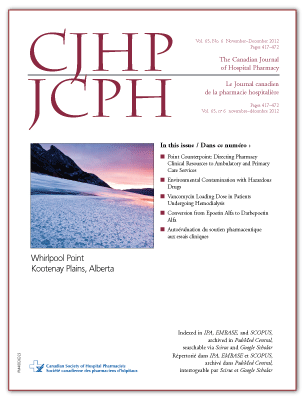Factors Influencing Vancomycin Loading Dose for Hospitalized Hemodialysis Patients: Prospective Observational Cohort Study
DOI:
https://doi.org/10.4212/cjhp.v65i6.1191Keywords:
vancomycin, hemodialysis, dosing, vancomycine, hémodialyse, posologieAbstract
ABSTRACT
Background : The increasing use of vancomycin to treat methicillinresistant Staphylococcus aureus (MRSA) has resulted in reduced susceptibility of MRSA to this drug. It is important to optimize vancomycin dosing in patients who are undergoing hemodialysis to attain a pre-hemodialysis serum concentration sufficient to eradicate MRSA, in accordance with recent guideline recommendations.
Objectives : To establish the optimal strategy for vancomycin loading dose in patients undergoing hemodialysis and to explore the determinants of pre-hemodialysis serum concentration of vancomycin measured in these patients.
Methods : A prospective observational cohort study was conducted between January and June 2010. Eligible participants were adults with established stage 5 chronic kidney disease who were undergoing inpatient hemodialysis. Data were collected on loading dose administered, body weight, serum concentration of vancomycin before the subsequent hemodialysis session (pre-hemodialysis concentration), and time between end of vancomycin infusion and measurement of pre-hemodialysis serum concentration. Multivariate stepwise linear regression was performed to examine independent associations between variables and measured pre-hemodialysis serum concentration of vancomycin.
Results : Eighty-one patients were included in the study. Of 24 patients who achieved the recommended pre-hemodialysis serum concentration of vancomycin (15–20 mg/L), 14 had a loading dose between 15 and 20 mg/kg. Further analysis suggested that the pre-hemodialysis serum concentration of vancomycin was independently associated with weightbased loading dose (mg/kg) (ß = 0.293, p = 0.003), age (ß = –0.358, p < 0.001), and time between administration of the loading dose and initiation of hemodialysis (ß = –0.247, p = 0.011).
Conclusions : The findings of this study indicate that a loading dose of 15–20 mg/kg (actual body weight) is likely to yield an optimal pre-hemodialysis serum concentration at a median elapsed time of 24 h. In addition to loading dose, patient age and time between administration of the loading dose and initiation of hemodialysis also influenced the pre-hemodialysis serum concentration of the drug.
RÉSUMÉ
Contexte : L’utilisation accrue de vancomycine pour traiter les infections à Staphylococcus aureus résistant à la méthicilline (SARM) a entraîné une réduction de la sensibilité du SARM à ce médicament. Il est important d’optimiser la posologie de la vancomycine chez les patients hémodialysés pour obtenir une concentration sérique préalable à l’hémodialyse suffisante pour éradiquer le SARM, conformément aux recommandations récentes des lignes directrices.
Objectifs : Établir la dose d’attaque optimale de la vancomycine chez les patients subissant une hémodialyse et examiner les déterminants de la concentration sérique de la vancomycine préalable à l’hémodialyse chez ces patients.
Méthodes : Une étude de cohorte observationnelle prospective a été menée entre janvier et juin 2010. Les patients admissibles étaient des adultes atteints d’une néphropathie chronique de stade 5 subissant une hémodialyse en milieu hospitalier. Les données ont été recueillies pour la dose d’attaque administrée, le poids corporel, la concentration sérique de vancomycine avant la séance d’hémodialyse subséquente (concentration préalable à l’hémodialyse) et le temps entre la fin de la perfusion de la vancomycine et la mesure de la concentration sérique préalable à l’hémodialyse. Une analyse par régression linéaire séquentielle a été réalisée pour examiner les associations indépendantes entre les variables et la concentration sérique de vancomycine mesurée avant l’hémodialyse.
Résultats : Au total, 81 patients ont été admis à l’étude. Des 24 patients qui ont obtenu la concentration sérique de vancomycine recommandée préalablement à l’hémodialyse (15–20 mg/L), 14 ont reçu une dose d’attaque de 15 à 20 mg/kg. D’autres analyses ont suggéré que la concentration sérique de vancomycine préalable à l’hémodialyse était associée de façon indépendante à la dose d’attaque fondée sur le poids (mg/kg) (ß = 0,293, p = 0,003), à l’âge (ß = –0,358, p < 0,001) et au temps écoulé entre l’administration de la dose d’attaque et le début de l’hémodialyse (ß = –0,247, p =0,011).
Conclusions : Les résultats de cette étude montrent qu’une dose d’attaque de 15 à 20 mg/kg (poids corporel réel) est susceptible de produire une concentration sérique optimale de vancomycine préalablement à l’hémodialyse dans un temps médian de 24 h. Outre la dose d’attaque, l’âge du patient et le temps écoulé entre l’administration de la dose d’attaque et le début de l’hémodialyse ont également influencé la concentration sérique de vancomycine préalable à l’hémodialyse.
Downloads
Published
Issue
Section
License
Copyright © Canadian Society of Healthcare-Systems Pharmacy.
After publication of a manuscript in the CJHP, the authors of the manuscript must obtain written permission from the CSHP (publications@cshp.ca) before reproducing any text, figures, tables, or illustrations from the work in future works of their own. If a submitted manuscript is declined for publication in the CJHP, all said rights shall revert to the authors. Please note that any forms (e.g., preprinted orders and patient intake forms) used by a specific hospital or other health care facility and included as illustrative material with a manuscript are exempt from this copyright transfer. The CJHP will require a letter from the hospital or health care facility granting permission to publish the document(s).










